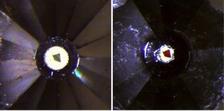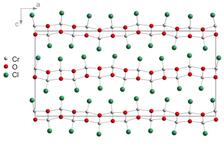A single crystal of CrOCl inside a diamond anvil cell (view through one of the diamonds) at low pressure and at 51 GPa. (Credit: Maxim Bykov/Universität Bayreuth)
Using DESY's X-ray source PETRA III, scientists have observed for the first time how layers in certain crystals buckle under high pressure, forming a complex inner structure. The study led by Prof. Sander van Smaalen from the University of Bayreuth opens the view into the complex nature of layered compounds. The team presents its findings in the journal Scientific Reports (Nature Publishing Group).
“The properties of solids possessing a layer-type crystal structure are of broad interest,” explains the study's first author Maxim Bykov from van Smaalen's group. “They have found applications as lubricants, but they are also the basis of physical properties like superconductivity, charge-density waves and the topological insulating effect.” In these materials, layers of the compound are held together by weak van der Waals forces. “Application of external pressure is a tool to tune structural parameters and study how the forces within the layers and between the layers evolve,” says Bykov.
The team investigated a compound made of chromium (Cr), oxygen (O) and chlorine (Cl). Chromium oxychloride (CrOCl) is a layered-type material and represents a group of similar compounds containing different metals. The researchers put tiny CrOCl single-crystals into a diamond anvil cell and applied up to 560,000 times the atmospheric pressure (up to 56 gigapascals, GPa). With the extremely bright X-rays of PETRA III they followed the evolution of the inner structure of the material as the pressure increased.
“For decades it was expected that the inner structure of any material gets simpler the more pressure you apply,” explains Dr. Hanns-Peter Liermann, co-author of the paper and head of the DESY measuring station P02 at PETRA III where some of the experiments were performed. “Then, about 15 years ago it emerged that this is not always the case: Some simple crystal structures of elements surprisingly get more complex under pressure.” However, for multi-elements compounds like CrOCl this effect is not well-established.
“Applying pressure to Chromium oxychloride, we have discovered a structural phase transition above 150 thousands atmospheres or 15 gigapascals towards an aperiodic modulated phase,” reports co-author Prof. Leonid Dubrovinsky from the University of Bayreuth. “This peculiar state of matter exhibits all properties typical for crystalline materials, but it lacks the periodicity found in usual crystals.” It is the first time, that such an incommensurate high-pressure phase has been described in detail in a complex solid under pressure.
“At low pressures, the van der Waals contacts between the chlorine atoms of adjacent layers are weak,” explains van Smaalen. “At higher pressures, the repulsion between the chlorine atoms of adjacent layers becomes of equal importance as the interatomic bonding within each layer. CrOCl tries to achieve an optimized configuration and this leads to a buckling of the chromium-oxygen layers.” The scientists followed the crystal structure further up the pressure scale and found that at 51 gigapascals the material again reorganizes into a simple periodic superstructure. “Using single-crystal X-ray diffraction at a source like PETRA III we have been able to describe for the first time the evolution of an incommensurate crystal structure in dependence on pressure,” says van Smaalen.
“Similar high-pressure behaviour can be expected for a wide range of materials with weak and strong chemical bonds at ambient conditions,” says Bykov. “A better understanding of this behaviour doesn't only give us new insights into the phenomenon of incommensurate phases. It may also allow to fine-tune the properties of promising novel materials for different applications.”
(from DESY News)
Reference:
Pressure-induced normal-incommensurate and incommensurate-commensurate phase transitions in CrOCl; Maxim Bykov, Elena Bykova, Leonid Dubrovinsky, Michael Hanfland, Hanns-Peter Liermann and Sander van Smaalen; Scientific Reports, 2015; DOI: 10.1038/srep09647









